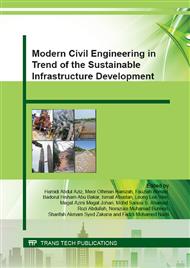[1]
T. M Ahlborn, D.K. Harris, D.L. Misson and E.J. Peuse, Strength and Durability Characterization of Ultra-High Performance Concrete under Variable Curing Conditions. Transportation Research Record Design of Structures, Journal of the Transportation Research Board (2011).
DOI: 10.3141/2251-07
Google Scholar
[2]
B.A., Graybeal, L.J., Hartmann. Strength and Durability of Ultra-High Performance Concrete. 3rd International Symposium on High Performance Concrete, Orlando, Florida(2003).
DOI: 10.21838/uhpc.16679
Google Scholar
[3]
M.N. Fardis, Innovative materials and techniques in concrete construction: ACES Workshop. Springer Dordrecht Heidelberg London New York: University of Patras; (2012).
Google Scholar
[4]
A. Spasojevic´, Structural implications of ultra-high performance fiber reinforced concrete in bridge design. Ph.D. thesis, EPFL; (2008).
Google Scholar
[5]
K. Habel, M. Viviani, E. Denarié, E. Brühwiler, Development of the mechanical properties of an ultra-high performance fiber reinforced concrete (UHPFRC). Cem Concr Res 36(7) (2006) 1362–70.
DOI: 10.1016/j.cemconres.2006.03.009
Google Scholar
[6]
S. Benson, B. Karihaloo, CARDIFRC_-development and mechanical properties. Part I: Development and workability. Mag Concr Res , 57(6) (2005) 347–52.
DOI: 10.1680/macr.2005.57.6.347
Google Scholar
[7]
K. Holschemacher, D. Weiße, Economic mix design of ultra-high strength. Concrete (2005)1133–44.
Google Scholar
[8]
B. Divsholi, D. Lim, S. Teng. Mechanical properties and durability of high performance concrete incorporating ultra fine slag mechanical properties and durability of high performance concrete incorporating ultra fine slag (2011).
DOI: 10.1016/j.conbuildmat.2012.11.052
Google Scholar
[9]
E. Worrell, L. Price, N. Martin, C. Hendriks, L.O. Meida, Carbon dioxide emissions from the global cement industry 1. Annu Rev Energy Env, 26(1) (2001) 303–29.
Google Scholar
[10]
M.F. Arshad, Influence of multiple blended binders on engineering properties and durability of concrete Ph. D thesis. Malaysia, Universiti Sains Malaysia; (2010).
Google Scholar
[11]
S. Rukzon, P. Chindaprasirt, An experimental investigation of the carbonation of blended portland cement palm oil fuel ash mortar in an indoor environment. Indoor Built Environ 18(4) (2009) 313–8.
DOI: 10.1177/1420326x09336554
Google Scholar
[12]
W. Tangchirapat, J. Tangpagasit, S. Waew-kum, C. Jaturapitakkul, A new pozzolanic material from palm oil fuel ash. KMUTT Res Dev J, 26(4) (2003) 459–73.
Google Scholar
[13]
M.A. M Johari, A.M. Zeyad, N. Muhamad Bunnori N,K.S. Ariffin, Engineering and transport properties of high-strength green concrete containing high volume of ultrafine palm oil fuel ash. Constr Build Mater , 30 (2012) 281–8.
DOI: 10.1016/j.conbuildmat.2011.12.007
Google Scholar
[14]
J.H. Tay, Ash from oil-palm waste as a concrete material. J Mater Civ Eng, 2(2) (1990) 94–105.
DOI: 10.1061/(asce)0899-1561(1990)2:2(94)
Google Scholar
[15]
A. Awal, M. Hussin, Durability of high performance concrete containing palm oil fuel ash. In: 8th International conference on durability of building materials and components; 8 dbmc1999. p.465–74.
Google Scholar
[16]
C. Jaturapitakkul, K. Kiattikomol, W. Tangchirapat, T. Saeting, Evaluation of the sulfate resistance of concrete containing palm oil fuel ash. Constr Build Mater, 21(7) (2007) 1399–405.
DOI: 10.1016/j.conbuildmat.2006.07.005
Google Scholar
[17]
M. Ahmad, R. Omar, M. Malek, N. Noor, S. Thiruselvam, Compressive strength of palm oil fuel ash concrete. In: Proc of the international conference on construction and building technology. Kuala Lumpur, Malaysia; 2008. p.297–306.
Google Scholar
[18]
M. Karim, M. Zain, M. Jamil, M. Islam, Strength of concrete as influenced by palm oil fuel ash. Aust J Basic Appl Sci, 5(5) (2011) 990–7.
Google Scholar
[19]
Momayez et al, Comparison of method evaluating bond strength between concrete substrate and repair materials Cement and Concrete Research, 35 (4) (2005) p.748–757.
DOI: 10.1016/j.cemconres.2004.05.027
Google Scholar
[20]
B. Tayeh, B. Bakar, M. Johari et al., Evaluation of Bond Strength between Normal Concrete Substrate and Ultra High Performance Fiber Concrete as a Repair Material. Procedia Engineering, 54 (2013) Pages 554-563.
DOI: 10.1016/j.proeng.2013.03.050
Google Scholar
[21]
M.A.A. Aldahdooh, N. Muhamad Bunnori, M. Johari (2013) Development of green ultra-high performance fiber reinforced concrete containing ultrafine palm oil fuel ash. Construction and Building Materials, 48 (2013) Pages 379-389.
DOI: 10.1016/j.conbuildmat.2013.07.007
Google Scholar
[22]
N. Shafiq, J. Cabrera, J. Effects of initial curing condition on the fluid transport properties in OPC and fly ash blended cement concrete. Cement and Concrete Composites, 26 (4) (2004) pp.381-387.
DOI: 10.1016/s0958-9465(03)00033-7
Google Scholar
[23]
C.J. Stunbeck, Durability of Ternary Blended Cements in Bridge Applications. Master Thesis, University of Missouri, Columbia, USA, (2007) p.115.
Google Scholar
[24]
P.C. Aitcin, A. Neville, High-performance concrete demystified. Concrete international, 15(1) (1993) pp.21-26.
Google Scholar
[25]
A.M. Neville, Properties of concrete. Prentice Hall, (2012) p.872.
Google Scholar
[26]
N.S. Martys, C.F. Ferraris, Capillary transport in mortars and concrete. Cement and concrete research, 27(5) (1997) pp.747-760.
DOI: 10.1016/s0008-8846(97)00052-5
Google Scholar
[27]
R. Kumar, B. Bhattacharjee, Assessment of permeation quality of concrete through mercury intrusion porosimetry. Cement and concrete research, 34(2) (2004) pp.321-328.
DOI: 10.1016/j.cemconres.2003.08.013
Google Scholar
[28]
A. Tamimi, J. Abdalla and Z. Sakka, Prediction of long term chloride diffusion of concrete in harsh environment. Construction and Building Materials, 22(5) (2008) pp.829-836.
DOI: 10.1016/j.conbuildmat.2007.01.001
Google Scholar
[29]
B. Liu, Y. Xie and J. Li, Influence of steam curing on the compression strength of concrete containing supplementary cementing materials. Cement and concrete research, 35(5) (2005) pp.994-998.
DOI: 10.1016/j.cemconres.2004.05.044
Google Scholar


